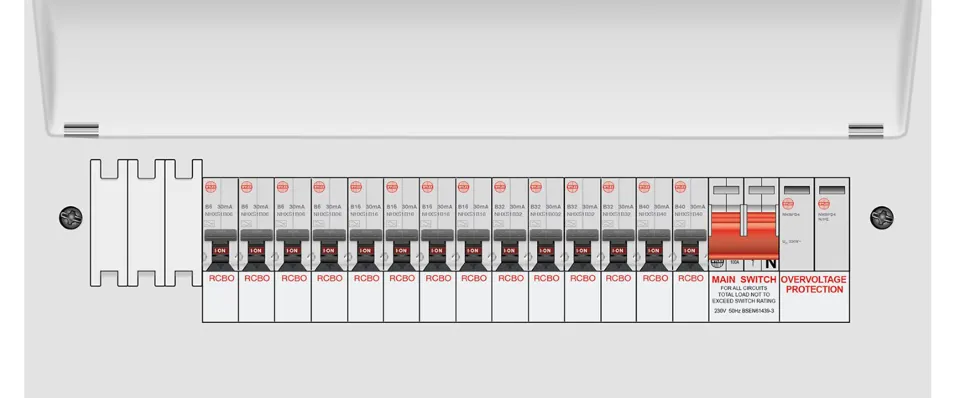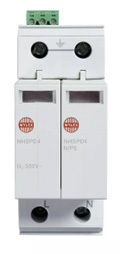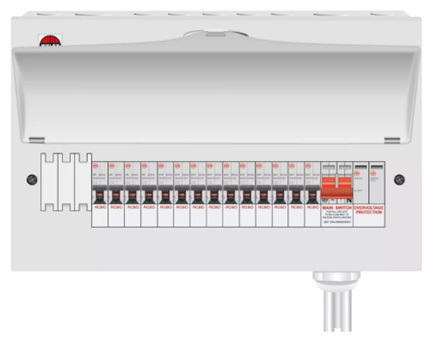
Surge Protective Devices (SPDs)
The effects of a surge can result in either instant failure or damage to the equipment, only evident over a longer period of time. SPDs are usually installed within a consumer unit or a distribution board to protect an electrical installation and connected equipment but can also be installed locally to protect an individual item of equipment. A surge can be transmitted via other incoming services such as telephone lines, some cable TV networks etc., so it is important to remember to consider all routes a surge can enter the property. For information regarding overvoltages transmitted by information and communication technologies, see BS EN 50174, BS EN 62305-4, PD CLC/TS 61643-22 and, for telecoms systems in general, see BS 6701.
There are three common types of SPD:
- Type 1 SPD installed at the origin, for example, main distribution board.
- Type 2 SPD installed at sub-distribution boards.
(Combined Type 1 and 2 SPDs are available and are usually installed in consumer units.) - Type 3 SPD installed close to the protected load. These must only be installed as a supplement to a Type 2 SPD.
Where multiple SPD devices are required for protection throughout the installation, they must be coordinated in accordance with Regulation 534.4.4.5 to ensure correct operation. SPDs supplied by different manufacturers should be confirmed for suitability as required by Regulation 536.4.203.
Figure 1 Surge protector (Image credit: Electrium)

What are transient overvoltages?
Transient overvoltages can be defined as short duration, high magnitude voltage peaks with fast rising edges, commonly referred to as ‘surges’, which can range from a few volts to many thousands of volts on a low-voltage consumer network, for no more than millisecond duration.
These surges occur due to the sudden release of energy previously stored or induced by other means. This energy can then find its way into electrical installations, naturally occurring either indirectly from lightning strokes or directly from lightning strikes, or created by the switching and operation of certain equipment within an installation.
How do transient overvoltages occur?
Transient overvoltages occur when equipment likely to produce switching overvoltages or disturbances exceeding the applicable rated impulse voltage of equipment according to Table 443.2 of BS 7671, are installed locally. Equipment such as large inductive or capacitive equipment, motors, transformers, capacitor banks, storage units or high current loads.
Historically, this has not been an issue within domestic installations but, more recently, installations are changing with the advent of recent technologies such as electric vehicle charging, air/ground source heat pumps and speed-controlled washing machines. These technologies have made transients more likely to occur within domestic installations at some level.
Transient overvoltages due to atmospheric origin can occur if either the property itself or nearby electrical transmission infrastructure suffers a hit by lightning strokes. These types of transient overvoltages are most likely to happen when a direct lightning stroke on an adjacent overhead power or telephone line causes the transient overvoltage to conduct along the lines into nearby properties, which can cause considerable damage to the electrical installation and associated equipment. BS EN 62305-2 contains information required for risk management for protection against transient overvoltages due to direct or nearby lightning strokes on the structure.
Where are SPDs required?
The current edition of the IET Wiring Regulations, BS 7671:2018+A2:2022, states in Regulation 443.4.1:
“Protection against transient overvoltages shall be provided where the consequence caused by overvoltage could result in:
- serious injury to, or loss of, human life
- failure of a safety service, as defined in Part 2
(This has been deleted by BS 7671:2018+A2:2022 - Corrigendum (May 2023)) - significant financial or data loss.
For all other cases, protection against transient overvoltages shall be provided unless the owner of the installation declares it is not required due to any loss or damage being tolerable and they accept the risk of damage to equipment and any consequential loss.”
Regulation 443.4.2 goes on to state that protection against overvoltages shall be considered due to equipment likely to produce switching overvoltages or disturbances exceeding the applicable rated impulse voltage of equipment according to Table 443.2. It is therefore important to check with the manufacturer of any installed equipment and confirm the rated impulse voltage level of the equipment to be installed, to make an informed choice regarding the decision.
It is important to remember that in the introduction to BS 7671:2018+A2:2022 it states:
“Existing installations that have been installed in accordance with earlier editions of the Regulations may not comply with this edition in every respect. This does not necessarily mean they are unsafe for continued use or require upgrading.”
Regulation 132.16 also states:
“No addition or alteration, temporary or permanent, shall be made to an existing installation, unless it has been ascertained that the rating and the condition of any existing equipment, including that of the distributor, will be adequate for the altered circumstances. Furthermore, the earthing and bonding arrangements, if necessary for the protective measure applied for the safety of the addition or alteration, shall be adequate.”
In summary, unless required by one of the indents in Regulation 443.4.1 or if a lightning protection system (LPS) is installed, the decision on whether to install SPDs is in the hands of the owner of the installation, but they should be provided with enough information to make an informed decision on whether they wish to omit SPDs. A decision should be made based on any existing risk factors and following a cost evaluation of SPDs, which may cost less than it would to replace equipment that may be damaged from the effects of an overvoltage.
An approved electrician can help assess the need for SPDs and any risk factors that may exist, and manufacturers of surge protective devices can help advise on required protection levels and coordination of devices.
Overvoltage protection could be installed in an existing consumer unit where appropriate physical space is available. Alternatively, where insufficient space is available, overvoltage protection could be installed in an external enclosure adjacent to the existing consumer unit.
Many home insurance providers cover lightning strokes but surges caused by equipment or faults can vary depending on the cause of the surge, so, it is important to check your home insurance policy.
For requirements when selecting and installing SPDs for an electrical installation, where required, see Section 534 and Appendix 16 of BS 7671:2018+A2:2022.
Figure 2 Surge protected consumber unit (Image credit: Electrium)

